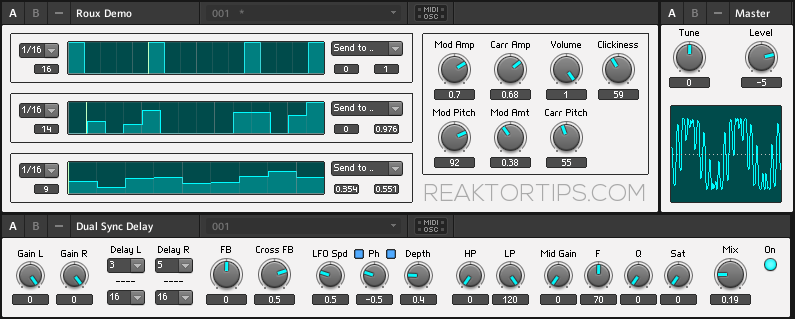Back in the day when I was blogging at the now-defunct kore.noisepages.com, I did a series on the inner structure of a basic sequencer macro, one that could be easily adapted for many uses. Those posts have vanished into the bit-ether, so I’m rebooting the topic with a revised macro and an ensemble that shows how to use it. And here it is! download link
All controls are tool tipped – there’s sequence length and clock speed controls, an IC send menu and value range controls – see below for details.
Last time around, I posted the macro and dived right into the inner structure, explaining it bit by bit from the inside out. I think this was useful but lacked a degree of… instant gratification. So this time around I’m going to start with a simple demo ensemble that shows how you can use it right off the bat.
This demo instrument is a rhythmic FM noisemaker that has three sequencer macros mapped to the volume, carrier pitch and modulation amount. The modulation oscillator pitch isn’t sequenced – it’s fun to map it to a MIDI or OSC controller and manipulate in real-time. You can get some fine Clicks and Cuts style sounds and sequences out of it. I’ve run it through the standard factory library Dual Sync Delay to wet the sound a bit. Here it is with a little ParamDrum beat behind it:
The Roux macro can be slapped into any Reaktor instrument, and doesn’t even require wiring stuff together. Using the IC send module, the signal can be routed to any target in an ensemble – such as knobs and faders in an existing instrument. It’s designed, therefore, for quick and dirty hot-wiring. Plop one into Carbon 2, for example, and add some sequencing to oscillator pitches and cutoff values.
One nice thing about the IC send module is that it displays a menu right on the front panel of the instrument that lets you direct the signal without mucking around in module properties. Another great thing is that it adapts the signal range to the target you’re aiming at – doesn’t matter whether the target has values from -12 to +12 or 0 to 127. As an added tweak, I’ve included min and max controls that will restrict the range, in case you want a target control’s travel limited to, say, the middle range – just set min to 0.4 and max to 0.6.
Now, why is this macro called the Roux? A roux is the basis for sauces in french cooking – it’s little more than flour fried in fat, and you can make gravies, cheese sauces, any kind of sauce where you want a little body and thickness. And just like the sauce base, this sequencer macro can be used in a lot of different ways, as the basis for different instrument designs.
In upcoming posts I’ll talk about other ways to use the macro, like triggering envelopes, build some new instruments with it, and we’ll take a peek under the hood at what makes it tick. Bon appetit!
 |
| I was raised to be a saucier. A great saucier. |











